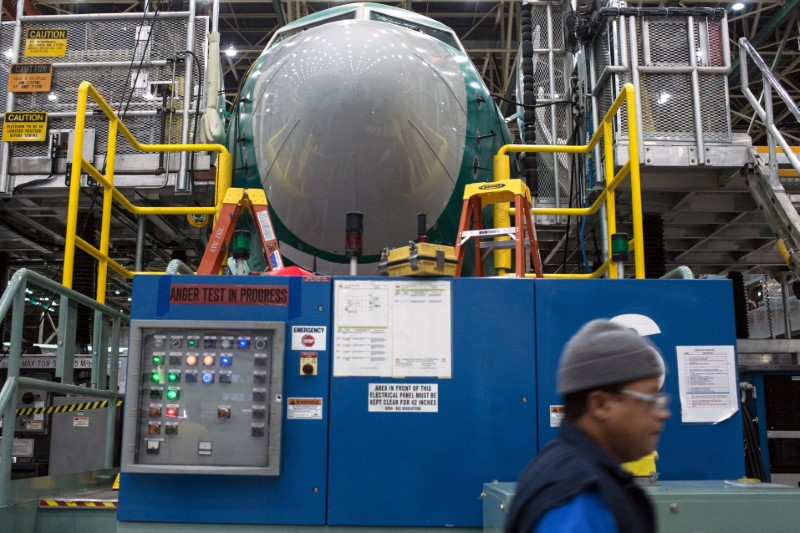By Lucia Mutikani
WASHINGTON (Reuters) - U.S. factory activity accelerated to a two-year high in December amid a surge in new orders and rapidly rising raw material prices, indicating that some of the drag on manufacturing from prolonged dollar strength and a slump in oil prices was fading.
Other data on Tuesday showed U.S. construction spending hit a 10-1/2-year high in November, providing a boost to a fourth-quarter economic growth estimate. The reports suggested President-elect Donald Trump would inherit a strong economy, with a labor market that is near full employment, from the Obama administration.
"The economy is ending the year on a high note with even the manufacturing sector showing signs of faster growth. It appears that President (Barack) Obama will be leaving his successor with a pretty good economy," said Joel Naroff, chief economist at Naroff Economic Advisors in Holland, Pennsylvania.
The Institute for Supply Management (ISM) said its index of national factory activity rose 1.5 percentage points to 54.7 last month, the highest level since December 2014. A reading above 50 indicates an expansion in manufacturing, which accounts for about 12 percent of the U.S. economy.
A gauge of new orders jumped 7.2 percentage points to its highest level since November 2014. Twelve industries, including petroleum, electrical equipment, appliances and components and machinery, reported growth in new orders last month.
Export orders also rose, but order backlogs were unchanged. A measure of factory employment hit its highest since June 2015 and the production sub-index rose 4.3 percentage points.
Manufacturers reported paying more for raw materials, which suggests producer inflation could push higher in coming months. The ISM's prices index surged 11 percentage points to its highest level since 2011. It was the 10th straight month of increases in raw materials prices.
Last month, 38 percent of supply executives in the ISM survey reported paying higher prices.
"The sharp rise in the prices index plays into the global 'reflation' theme with investors pointing to rising input prices in China and elsewhere as signaling a potential return to higher inflation rates," said Andrew Hollenhorst, an economist at Citigroup (NYSE:C) in New York.
STRONG DOLLAR A THREAT
A collapse in oil prices in 2015 and a surge in the dollar has hobbled manufacturing. Much of the impact has been through weak business spending on equipment, which has contracted for four straight quarters.
But with oil prices rising and touching 18-month highs on Tuesday, manufacturing is perking up. Gas and oil well drilling has risen over the last several months.
Renewed dollar strength following Trump's November election victory could, however, limit gains in factory activity. Trump has pledged tax cuts and massive infrastructure spending, an expansionary fiscal policy agenda that could fan inflation and spur a faster pace of interest rate increases by the Federal Reserve.
The dollar hit a fresh 14-year high against a basket of currencies on Tuesday's data, while prices for U.S. government debt fell. U.S. stocks traded higher.
In a separate report the Commerce Department said construction spending increased 0.9 percent to $1.18 trillion in November, the highest level since April 2006. It was boosted by gains in both private and public sector investment.
The solid increase in construction spending prompted the Atlanta Fed to raise its fourth-quarter GDP estimate by four-tenths of a percentage point to a 2.9 percent annual rate. The economy grew at a 3.4 percent pace in the third quarter.
Spending on private construction projects jumped 1.0 percent in November to the highest since July 2006 as single-family home building, as well as home renovations, increased.
Investment in private nonresidential structures, which include factories, hospitals and roads, rose 0.9 percent after tumbling 1.5 percent the prior month.
"The outlook for nonresidential investment spending lies in the as-yet-unknown infrastructure plans of the new administration," said John Ryding, chief economist at RDQ Economics in New York.

"However, in nominal dollar terms, nonresidential construction spending is within one percent of the October 2008 high and this may be a further indication of the limited degree of slack in the construction sector that could be deployed on infrastructure projects."Public construction spending rose 0.8 percent in November to the highest level since March. It was the fourth straight month of increases.